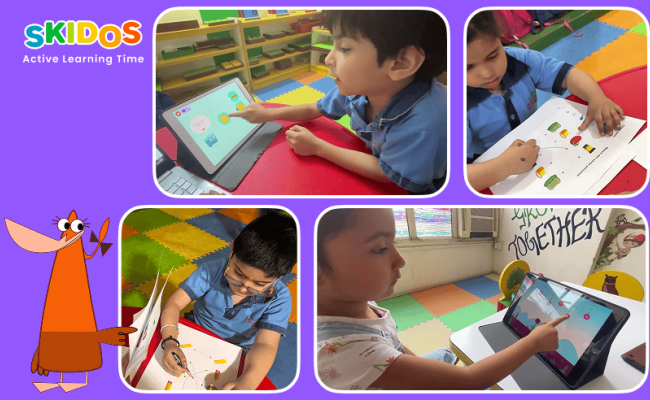We at SKIDOS recently conducted a comprehensive classroom study to put this to the test, comparing the efficacy of our digital learning products for Math and Learn to Read against traditional analog teaching methods, specifically structured worksheets.
The Study: A Fair Fight Between Digital & Traditional
Our comparative efficacy analysis took place directly in a school classroom, meticulously designed to evaluate learning outcomes and student engagement. We employed a two-phase approach:
Analog Phase
Students completed worksheets carefully designed to replicate the digital tasks.

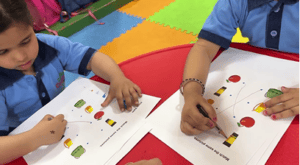
Digital Phase
Students engaged with SKIDOS Digital Math and Learn to Read products.

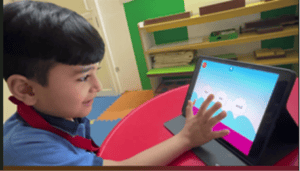
To ensure a robust comparison, we maintained consistency across both methods. This included equivalent content coverage, i.e., the same number of topics and questions in both digital and analog formats, and a standardized pedagogical approach. For example, if a “Number Sense” topic had 20 digital math questions, the analog worksheet featured 20 corresponding ones mirroring the digital version.
We measured 5 core metrics: Prior Awareness, Accuracy, Curiosity & Interest, Engagement, and Time taken.
The Results Are In: Digital Dominates Across the Board!
In an era where technology is reshaping education, our findings consistently highlight how digital learning powered by SKIDOS surpasses traditional methods across multiple essential learning metrics. From time efficiency to accuracy, engagement, and curiosity, SKIDOS tools prove to be game-changers in fostering deeper and more effective learning experiences.
A. SKIDOS Learn to Read
Time Taken
The decrease from 1,492 units in analog to 1,166 units in digital indicates that children completed tasks approximately 22% faster with the digital learning tool. This improvement highlights enhanced speed, efficiency, intuitive navigation, increased focus, and more effective problem-solving, all of which are reinforced by instant feedback mechanisms that optimize learning outcomes.
| Metric |
Analog |
Digital |
| Time Taken |
1492 |
1166 |
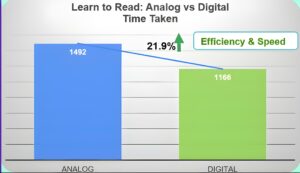
Accuracy (+50.8%)
Students using the digital product demonstrated higher accuracy, indicating stronger retention and more effective application of concepts. This suggests that digital tools enhance comprehension by reinforcing learning through interactive engagement, immediate feedback, and adaptive problem-solving techniques.
Curiosity & Interest (+17.6%)
The increase in this metric reflects greater curiosity and deeper exploration, likely spurred by dynamic digital interactions that promote hands-on discovery and adaptive learning experiences.
Engagement (+16.3%)
The rise in this metric indicates enhanced engagement and active involvement, driven by interactive game elements and instant response mechanisms that sustain attention and encourage deeper interaction.
Prior Awareness (+87.4%)
An impactful increase in prior awareness underscores the advantages of digital cues, structured guidance, and visual supports. This was evident through heightened confidence in digital interaction, improved concept recall, and faster response times, reflecting a stronger foundation and familiarity with key principles.
| Metrics |
Analog |
Digital |
| Accuracy |
604.5 |
911.5 |
| Curiosity/Interest |
415 |
488 |
| Engagement |
415 |
483 |
| Prior Awareness |
214.5 |
402 |
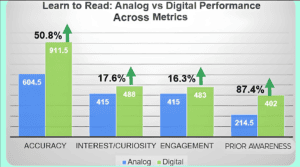
Final Score (38.6%)
Improvement in the final score indicates an increase in overall learning outcomes achieved through the use of the digital product.
|
Analog |
Digital |
| Final Score |
1649 |
2284.5 |
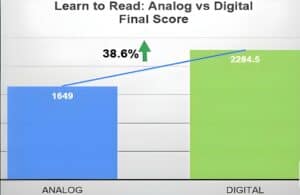
B. SKIDOS Math
Time Taken
The drop from 624 units in analog to 502 units in digital suggests that children completed tasks ~20% faster using the digital learning tool. It shows better speed, efficiency, navigation, focused engagement, and streamlined problem-solving with instant feedback.
| Metric |
Analog |
Digital |
| Time Taken |
624 |
502 |
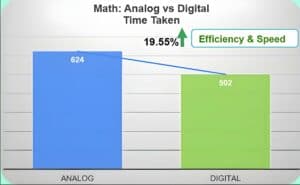
Accuracy (+9.16%)
Students using the digital product scored higher in accuracy, suggesting better retention and application of math concepts. It suggests better retention and application of math concepts.
Curiosity & Interest (+2.82%)
Improvement in this metric shows increased exploration and inquisitiveness, likely driven by interactive digital elements.
Engagement (+4.68%)
Improvement in this metric shows strengthened focus and participation, supported by gamified mechanics and real-time feedback.
Prior Awareness (+7.15%)
A modest yet meaningful improvement in prior awareness highlights the benefits of digital cues, guided instruction, and visual reinforcements in math learning. It was highlighted through increased confidence levels on digital engagement, concepts recalled correctly, and the speed of answering, indicating familiarity.
| Metrics |
Analog |
Digital |
| Accuracy |
1103 |
1204 |
| Curiosity/Interest |
177 |
182 |
| Engagement |
171 |
179 |
| Prior Awareness |
162.3 |
173.9 |
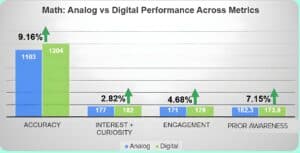
Final Score (7.79%)
Improvement in the final score indicates an increase in overall learning outcomes achieved through the use of the digital product.
|
Analog |
Digital |
| Final Score |
1613.3 |
1738.9 |
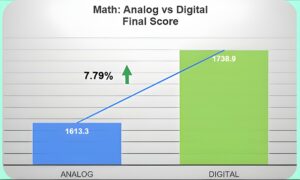
These findings emphasize how digital learning is not just a substitute; it’s an advancement, leading to higher engagement levels and deeper learning.
These numbers highlight how digital learning isn’t just about knowledge acquisition; it’s about cultivating intellectual curiosity and an active learning mindset.
The data-driven insights from SKIDOS reaffirm that technology-enhanced learning is more than just an alternative to traditional education; it’s an evolution. With higher speed, accuracy, engagement, and curiosity, digital tools are redefining learning experiences, making them more efficient, personalized, and interactive than ever before.
As the education landscape continues to evolve, embracing technology-driven approaches is not just beneficial—it’s essential for fostering deeper comprehension, sustained engagement, and greater learning outcomes for students worldwide.
Deeper Insights: Why Digital Works
Our classroom observations provided compelling reasons for these gains:
Enhanced Learning Dynamics: SKIDOS digital tools foster active learning through dynamic content, boosting motivation and curiosity.
Reduction in Errors: Instant feedback mechanisms minimize repetitive mistakes, reinforcing concepts effectively.
Boosted Confidence & Focus: Lower frustration levels and higher self-assurance contribute to positive learning experiences.
Aligning with Educational Research
Our study’s findings resonate strongly with established educational research models.
Experimental Design: Our approach demonstrated controlled comparisons and measurable learning improvements, making the research replicable and scalable. The fact that digital tools significantly outperformed analog methods indicates a strong correlation, reinforcing the validity of our findings.
TPACK Framework: Our results demonstrate how technology (TK) enhances pedagogy (PK) in both literacy and math, leading to improved content knowledge (CK) delivery.
SAMR Model: Digital tools are not just substituting worksheets; they are augmenting and modifying learning through improved functionality and interactivity.

